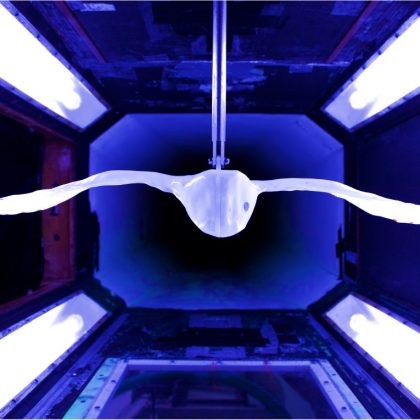Analysis of the vortex-dominated flow field over a delta wing at transonic speed
The Aeronautical Journal November 2023 Vol 127 No 1317
Introduction: the complexities of airflow over delta wings
In aerospace engineering, the complexities of airflow over delta wings have long remained an intriguing mystery. With their distinct low aspect ratios and highly swept leading edges, these wings play pivotal roles in aircraft ranging from fighter jets to supersonic civil transport vehicles. Yet, understanding and predicting the intricate flow dynamics, especially under transonic conditions, has proven to be a formidable challenge.

In this blog post, we embark on a journey into the world of transonic delta wing flow, guided by the findings of the research paper, “Analysis of the vortex-dominated flow field over a delta wing at transonic speed.” This study offers a compelling preview of state-of-the-art techniques and profound insights driving advancements in computational fluid dynamics for predicting and understanding vortex dynamics.
Observing the Complexities of the Flow Physics
The scientific paper highlights the critical role of turbulence in predicting the complex vortex-dominated flow field over delta wings. These vortex systems are generated from the turbulent wake of highly swept leading edges, making them a defining feature of such configurations. The challenge lies in correctly reproducing and modeling the turbulence, a puzzle that has perplexed turbulence modelers for decades.
The authors conducted scale-resolving simulations of a sharp leading-edge VFE-2 wing; the Spalart-Allmaras-based Improved Delayed Detached Eddy Simulation (IDDES) turbulence model was chosen to provide high-fidelity data. This approach can delve deep into flow physics, capturing the intricacies of vortex patterns, shock-vortex interactions, vortex breakdown, and more.
One of the critical aspects addressed in the paper is the sensitivity of the results to spatial and temporal resolution. Ensuring that the simulation data yields high prediction accuracy is paramount. The researchers compared their numerical results with experimental data concerning the mean surface pressure coefficient. The results align closely, validating the robustness of the approach.
The paper takes us through the turbulent world of transonic delta wing flow, offering us a peek into the underlying physics with the help of mean and instantaneous flow features. In the transonic regime, shock waves become significant players in the flow dynamics. The behavior of these shock waves is meticulously investigated, accurately capturing their positions and interaction with the leading-edge vortices. This precision in modeling the shock waves is vital for understanding and optimizing delta wing performance at transonic speed.
The interaction between Vortices and Shocks: Vortex Breakdown

The paper delves into the vortex flow patterns and the intriguing interaction between vortices and shocks. It becomes apparent that the scale-resolving approach excels in capturing the interplay between the leading-edge vortex and shock waves. Essential insights into these vortex and shock structures are presented. Particularly fascinating phenomena explored in the paper are the formation and breakdown of vortices, introducing an explanation for the mechanisms driving vortex breakdown.
The core of the inboard vortex is primarily composed of flow from the shear layer that detaches at the wing apex. Particles from this separated shear layer, originating from the leading edge of the wing apex, form the vortex core and move along the wing at high velocities. As the shear layer consistently feeds the vortex throughout the wing’s span, the vortex grows in size. This influx circles the primary core, reinforcing its structure and preserving its cohesiveness. This aspect underscores the importance of accurately capturing separation and turbulence proximate to the wing apex in delta-wing flow simulations.
Moreover, this phenomenon is supported by the secondary vortex’s existence. Over the wing, the secondary vortex becomes unsustainable, and the boundary layer detaches in the streamwise direction, leading to a recirculation zone. This fluid behavior inhibits the shear layer from coiling into the primary vortex and generates a turbulent flow. Consequently, the primary vortex, which loses its source of kinetic energy, becomes more vulnerable and more likely to breakdown.
Turbulence Unveiled
Turbulence, that ever-elusive and challenging aspect of fluid dynamics, is a central character in this story. The researchers scrutinized turbulence-related variables, including instantaneous eddy viscosity, resolved turbulence kinetic energy, and the components of the Reynolds-stress tensor. These variables provide a window into the turbulent behavior of the flow, revealing insights into the shear layer, vortex thickness, etc.
It has been shown, for example, that the initial development of resolved turbulence is slightly delayed. Resolved turbulence kinetic energy is predicted insufficiently in the very initial stage of the vortical flow but thereby affects the downstream development of the turbulent process, including the vortex breakdown onset position. Being situated within the well-known range of grey area issues, this observation can introduce slight adaptations to the turbulence model in future work.
Future Horizons
Significant strides made through scale-resolving simulations and advanced turbulence models like IDDES are recognized. This research sheds light on the mysteries of transonic vortex-dominated delta wing flow and serves as a reference point for future studies.
The paper’s findings suggest that the IDDES approach is promising for simulating delta wing flow, even under transonic conditions. This insight could prove invaluable for optimizing delta wing configurations in diverse aerospace applications.
In the horizon of future research, we anticipate further exploration of vortex structures and the unsteady nature of the flow. With each revelation, we inch closer to mastering transonic delta wing flow complexities, opening doors to safer and more efficient aviation.
Analysis of the vortex-dominated flow field over a delta wing at transonic speed by T. Di Fabbio, E. Tangermann, M. Klein.
This open access paper appears in Volume 127 – Issue 1314 of The Aeronautical Journal.
The Royal Aeronautical Society is the world’s only professional body dedicated to the entire aerospace community. Established in 1866 to further the art, science and engineering of aeronautics, the Society has been at the forefront of developments ever since.
www.aerosociety.com | National Aerospace Library catalogue & e-books
Book reviews covering academic, scientific and technical books covering aeronautical engineering and topics relating to it can be found here: www.aerosociety.com/news-expertise/national-aerospace-library/book-reviews

Journal: The Aeronautical Journal
Article: Analysis of the vortex-dominated flow field over a delta wing at transonic speed
Authors: Tony Di Fabbio, Eike Tangermann and Markus Klein






